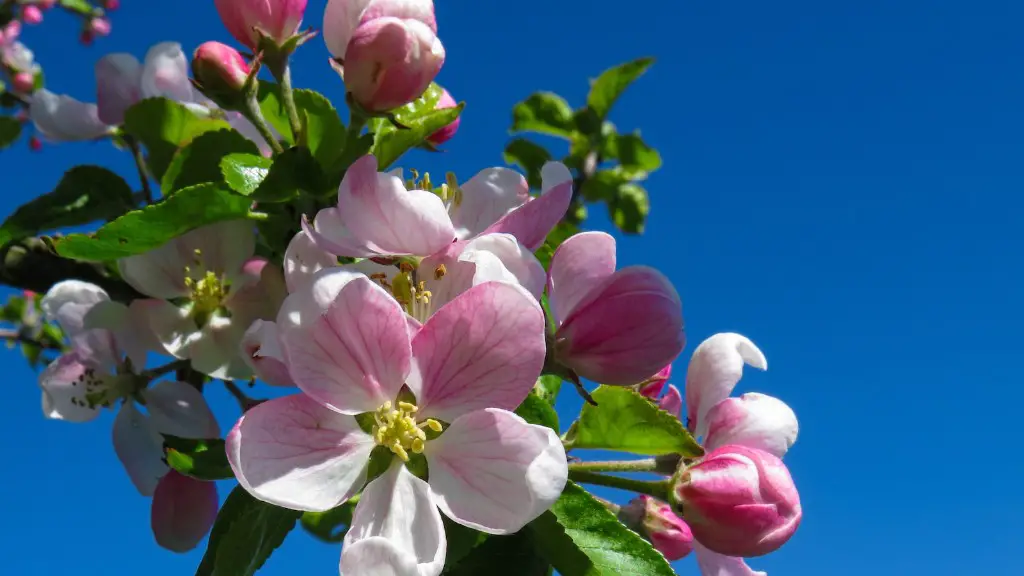Apple tree worms, also known as codling moths, are destructive pests that can cause significant damage to apple trees. The first step in getting rid of apple tree worms is to identify the species of the insect. Codling moths have a wide range of larvae, which can be identified by their size, color and shape. Some species are gray in color and up to three inches in length, while others are smaller and more yellowish in color. Once the species is identified, the next step is to take preventive measures to prevent a re-infestation.
The best way to get rid of apple tree worms is to use an insecticide. Neem oil is an effective natural insecticide that is safe for both humans and animals. However, it is important to read the label and follow the instructions before using it. Additionally, it is important to monitor the tree and apply the insecticide on a regular basis to prevent re-infestation.
In certain cases, chemical insecticides can also be used to get rid of apple tree worms. However, it is important to be aware of the potential hazards and health risks associated with the use of such chemicals. Additionally, chemical insecticides may not be effective in all cases and should be used only as a last resort.
Another way to get rid of apple tree worms is by using traps. These traps use food, such as apples, as bait to attract and trap the adult moths. The larvae then eat the apples and are trapped in the process. The traps need to be monitored regularly and the trapped worms should be destroyed to prevent them from escaping and re-infesting the tree.
Another way to prevent the spread of apple tree worms is to maintain healthy trees. When trees are healthy, they are more resilient to worms and other pests. Trees should be pruned regularly, watered correctly, and have their soil checked for proper nutrients. All branches and leaves should also be inspected for signs of infested bark or leaves. Proper sanitation should also be practiced, as unclean or damaged fruits can attract moths.
The last step in getting rid of apple tree worms is to inspect the area regularly and remove any infected areas. The infected fruits and leaves should be disposed of properly, as they can still contain larvae. Additionally, all garden debris, such as dead leaves and twigs, should be removed. This will help prevent further infestation and help restore the health of the apple tree.
Integrated Pest Management
Integrated pest management (IPM) is an effective method for getting rid of apple tree worms. IPM combines the use of physical, biological, and chemical controls which are all used together to manage and prevent pests. This method has been shown to be effective in controlling the spread of apple tree worms, as it eliminates or reduces their habitats, disrupts their reproductive cycles, and eliminates their food sources.
Physical control methods are designed to reduce the number of moths present in an area, such as removing food sources, pruning weak branches, or spraying insecticides. Biological methods, such as releasing predators or parasites, are also effective. These methods rely on natural predators to feed on the larvae and moths, thus reducing the infestation. Chemical control methods, such as insecticides, are also effective and should be used when necessary.
Monitoring is an important part of IPM, as it allows the user to determine if any methods need to be adjusted. Regular inspections should be conducted to check for infestations and to monitor the effectiveness of the IPM program. Additionally, records of the pest populations should be kept, as this will help the user to determine if any methods need to be adjusted.
IPM programs can be implemented on a regular basis, but it is important to be consistent in their use. Regular monitoring and inspection is also critical for the success of an IPM plan. Overall, IPM is an effective way to get rid of apple tree worms and should be used as part of a comprehensive pest management plan.
Organic Insecticides
Organic insecticides are a great alternative to chemical-based products when it comes to getting rid of apple tree worms. These products are formulated from natural ingredients, such as oils, soaps and other plant extracts, and are designed to be safe for people, pets and the environment. They can be applied directly to the infested area or sprayed around the tree in order to prevent future infestations.
Organic insecticides are an effective way to get rid of apple tree worms, as they disrupt the moths’ life cycles and eliminate their food sources. Additionally, they are less likely to harm beneficial insects, such as honeybees, and are safe for use around children and pets. However, it is important to read the label and follow the instructions for use.
Organic insecticides should be applied regularly in order to be effective. Additionally, mechanical traps can be used alongside the insecticides to help reduce the number of worms in the area. Finally, it is important to maintain healthy trees, as this will make them more resilient to pests and also increase their natural defenses.
Cultural Management of Apple Trees
Cultural management of apple trees is an important part of getting rid of apple tree worms. This involves implementing practices that promote the health and vigor of the tree and make it more resistant to pests and diseases. These practices can include pruning, fertilizing, mulching, and irrigating the tree properly. Additionally, making sure the tree is planted in an area with well-drained soil can also help.
Conducting regular inspections of the tree can also help to identify any weak or damaged areas which may be vulnerable to infestation. Any weak or damaged fruits should be removed and disposed of properly, as they can still contain larvae. Additionally, the tree should be monitored for signs of infestation, such as moth larvae and damaged leaves.
Pesticides and insecticides can also be used as part of a cultural management plan. However, it is important to use judiciously and for only targeted pests. Also, chemical treatments should be rotated with other control options, such as releasing predators or parasites, in order to reduce the risk of resistance.
Cultural management of apple trees is an important part of getting rid of apple tree worms. Maintaining healthy, vigorous trees by implementing the above practices will make them less susceptible to pests and diseases and can help reduce the need for chemical treatments. Additionally, regular inspections and monitoring of the tree will help to identify any weak or damaged areas that may be vulnerable to attack.
Organic Fungicides
Organic fungicides are another option for getting rid of apple tree worms. These products are formulated from natural ingredients and do not contain any synthetic chemicals. They can be used to control a variety of fungal diseases, such as apple scab, leaf spot, and powdery mildew, which are often a source of infestations by apple tree worms.
Organic fungicides should be applied according to the manufacturer’s instructions. Additionally, it is important to monitor the tree regularly and remove any infected fruits or twigs to prevent the spread of the fungus. Finally, pruning and maintaining a healthy tree can also help reduce the need for treating with fungicides.
Organic fungicides are an effective way to get rid of apple tree worms, as they can help to control the spread of fungal disease. They are also safe for people, pets, and the environment. However, it is important to read the label and follow the instructions for use in order to maximize their effectiveness.
Organic fungicides can be rotated with other control methods, such as introducing predators or parasites and using chemical or mechanical traps. Additionally, maintaining a healthy tree and conducting regular inspections can help to reduce the need for chemical treatments. Overall, organic fungicides are a great way to get rid of apple tree worms and should be part of a comprehensive pest management program.
Monitoring for Apple Tree Worms
Monitoring for apple tree worms is an important part of a comprehensive pest management program. Regular inspections should be conducted in order to identify any infestations and monitor the effectiveness of any control methods. Additionally, records of the pest populations should be kept, as this will allow users to track the progress of an IPM plan.
In order to monitor for apple tree worms, the tree should be inspected weekly for signs of pests and damaged fruits and leaves. Fruits should be checked for eggs, larvae, and any signs of infestation. Leaves and branches should also be checked for infested bark or larvae. Additionally, any damaged fruits or twigs should be removed and destroyed to prevent them from re-infesting the tree.
Once any signs of infestation have been identified, appropriate control measures can be implemented. Chemical or mechanical traps can be used to reduce the population of apple tree worms, while releasing predators or parasites can help to naturally control the population. Organic insecticides or fungicides can also be applied to reduce infestations and prevent the spread of infection.
Monitoring for apple tree worms is an important part of a comprehensive pest management program. Regular inspections and monitoring can help to identify any signs of infestation and prevent the spread of infection. Additionally, appropriate control measures, such as chemical or mechanical traps, releasing predators or parasites, and applying organic insecticides or fungicides, can help to control the population and restore the health of the tree.


